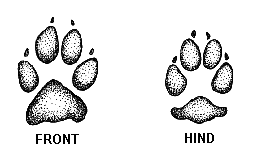|
Sounds (.wav
format)

Long Howl

Group Howl

Bark

Greeting

Challenge
|
|
|
.
| Order |
Carnivora |
| Family |
Canidae |
| Genus Species |
Canis latrans |
| Coat/Fur |
Reddish coat |
| Size |
20-80 pounds. Average about 24 pounds. A few may be over 50 pounds. Dr. Russell Mason, a Federal wildlife expert
in Utah, reported in the New York Times on July 27, 1999 that some coyotes now go up to 80 pounds. |
| Names |
Coyote, Canis latrans, prairie wolf, brush wolf, little wolf, songdog, coydog(though coydog is wrong, refers to
a cross breed) |
| Range |
Originally located in the praries and rockie mountains, now range in 48 states including Alaska and down into central
America. A coyote or pack will have a personal range of 2000-10000 acres, a bit more in the winter months as the
need for foods drives them a bit further. |
| Pups |
5-7 pups each year is typical, ranges from 2-15. Gestation period is 60 days |
| Habitat |
They live in the tropics, deserts, plains, moutains. |
| Life Span |
15 years |
| Den |
Tunneled hole in the side of a hill, under a tree. May have more than one den. |
| Tracks |
about 3 inches long, more oval shapped and not as round as a dog's paw. Front foot is larger than the hind. Claw
marks will show at the end of each toe. |
| Speed |
up to 40mph |
| First common cause of death |
Canine Distemper |
| Second most common cause of death |
Road killed by cars and trucks. |
| Diet |
Just about anything but primarily mice and other rodents. They will eat fruit, road killed animals and other dead
animals, and dog food off of back porches. |
| When seen |
Mostly coyote come out at night. They can be seen in early morning, and evening as they move to and from hunting
grounds. |
| Pack Structure |
One alpha male and female, who typically mate for life and are the only members of a pack to breed. Pack has 5-7
plus pups in the spring. Pups usually stay with the pack for a year or more and help with the next litter. After
that year several may leave the pack to form new packs in the fall...about October |
| Endangered Status |
They are not endangered, populations are higher than ever and ranges are wider than ever. |
| Teeth and Jaws |
42 teeth with long incisors and strong canine, strong jaws, great for grabbing and holding rodents. |
| Eyes, Nose, Ears |
Binocular vision, strong sense of smell and hearing |

  |

|
 Use this page for your school
reports. Use this page for your school
reports.
 There is always a little debate
on size of coyotes. Some people say they have never seen one over 24 pounds, some say they never see one smaller
than 50 pounds. There is always a little debate
on size of coyotes. Some people say they have never seen one over 24 pounds, some say they never see one smaller
than 50 pounds.
 Coyotes usually mate for life.
Only one couple in a coyote pack , the alpha male and alpha female, breed and have pups. Coyotes usually mate for life.
Only one couple in a coyote pack , the alpha male and alpha female, breed and have pups.
 80% of the coyote diet is mice
or other rodents. They are a great at rodent control. 80% of the coyote diet is mice
or other rodents. They are a great at rodent control.
 Coyote ranges and populations
are larger than they have ever been. Coyote ranges and populations
are larger than they have ever been.
 Coyotes have few predators
other than man, moutain lions and wolves are about all that might kill one. Coyotes have few predators
other than man, moutain lions and wolves are about all that might kill one.
 Only 30% of coyote pups make
it to adult hood. Only 30% of coyote pups make
it to adult hood.
 Wildlife experts feel that
75% of the coyote population could be killed each year, without causing damage to the overall population. Wildlife experts feel that
75% of the coyote population could be killed each year, without causing damage to the overall population.
 Ranchers and Farmers sometimes
use llamas to protect their sheep from coyotes. The llamas mix together with the sheep and are territorial enough
to keep the coyotes away. Sometimes donkeys are used in the same way. Ranchers and Farmers sometimes
use llamas to protect their sheep from coyotes. The llamas mix together with the sheep and are territorial enough
to keep the coyotes away. Sometimes donkeys are used in the same way.
 |



![]()